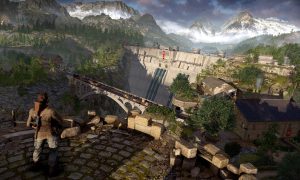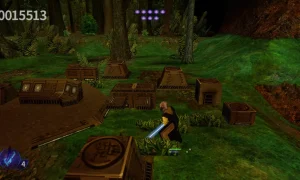Nowadays, if your favorite game goes out of print, just wait. If it got gamers talking during its first printing, you might just see it again–albeit in a different skin.
Evidently, enough people oohed and aahed over the gorgeous look of the game Seasons that game maker Libellud sent an old game to the plastic (and cardboard) surgeon for a facelift. The result is spectacular.
Lords of Xidit (Xidit = anagram of Libellud’s Spiel des Jahres-winning game Dixit) remakes Seasons designer Régis Bonnessée‘s old yak travel game, Himalaya, from 2004, places it in the Seasons universe, turns it to a hero vs. monster adventure, and pulls off one of the better game remakes I’ve played. What makes this refresh more delish is that Himalaya vanished when its first publisher, the tiny Tilsit Editions, went yak belly up in 2010.
See? Good games DO have a way of coming ‘round again.
That’s a hot tip too. Because solid game mechanics and fun remain lightning in a bottle. So, if you see a game resurrected, even if it has a revised theme or updated rules, chances are it made a lasting first impression.
Yak-traveling → monster-ridding
The objective of Lords of Xidit: Cleanse the Kingdom of Xidit of a plague of monsters, possibly unleashed by the sorcerers who summoned them in Seasons. You play a hero who travels from town to town, recruiting villagers of different capabilities to aide in your quest. Accumulate reputation, build Sorcerers’ Guild towers, and load up on gold. The player who avoids scoring the lowest in all three of those criteria will win.
All the pretty pieces
Dang, this box is deceptively heavy. Consider the contents:
- 70 figurines of five different types
- 75 Sorcerers’ Guild tower pieces
- 100 bard tokens
- 60 gold sovereign tokens
- 39 city tiles
- 6 Titan tiles
- 5 programming boards
- 5 order tokens
- 5 Idrakys cutouts and bases
- 5 player screens
- 18 score tokens
- 2 empty tokens
- 3 assessment tiles
- 3 calendar tiles
- 1 year wooden token
- 1 game board showing the Kingdom of Xidit
- 1 dummy player board with three tokens
- 1 bastion
- 1 first player token
- 1 rulebook
Bonuses:
- 1 map of the Kingdom of Xidit
- 1 exclusive Power card (two copies of familiar Speedwall, the Escaped) for the game Seasons
[singlepic id=19875 w=620 h=350 float=center]
For the most part, the game looks great and is typical French quality, though the box says “Made in China.” Oh well. The one deficient component: the flimsy player screens, which don’t have any heft and therefore fall over easily.
The small villager figurines feature impressive details, but they’re not painted. That would have been a lot to ask, though. The Idrakys (the name given to the players’ hero piece), are colorful cardboard standees. Too bad. Painted hero figurines (smell that expansion possibility?) would have rocked.
While the monsters come straight from the cards depicting familiars in Seasons, their tile size is a let down compared to Seasons’ larger cards. If you’ve not played Seasons, you might not comprehend the small, heavily stylized artwork depicting each fiend. Names for them on the tiles, as on the cards in Seasons, would have been nice.
The main game board is a six-fold (32 x 21 inches) monster in itself. When new, it may not lie perfectly flat, which means figurines may spend more time prone than vertical. Thankfully, the board contains a nearly invisible scoring track on the right edge to help calculate endgame reputation totals.
In the game, players select pre-planned moves/actions on the six dials on each player board according to the color of the road chosen for travel, an action taken, or a pause. This player board design in Xidit works better than the original boardless discs in the earlier incarnation of the game.
However…
The moment I saw the baggie in the box that contained the plastic rivets needed to secure all 30 dials to the five player boards, I got a sinking feeling. Sure enough, I was shy three full rivets. I fired off a request for the missing pieces to the game’s U.S. distributor, Asmodee. While mistakes like this do happen, it’s still disappointing. Asmodee took five days to respond to my email, but the response was personal and said I’d have the replacement pieces in the mail soon.
Daunting rulebook, simple play
The rulebook for Lords of Xidit is 20 pages long. Don’t panic, though.
The gameplay itself is simple, but piece management and variant rules add to the length. Really, most people should have it down after five minutes of play.
The game board shows 21 cities, which correspond to double-sided city tiles that contain recruitment info on one side and monster threat info on the other. Shuffle and sort these tiles into two stacks, one monster up, the other recruitment up. Match five monsters to the city numbers shown on the tiles and on the board and five recruitment to their city.
The monster threat tiles show how much reputation (bard harp), Sorcerer’s Guild tower stories, and gold a player can get for slaying the monster. Kill the baddies by matching your recruited villager units against the monster tile’s depicted units. Does that Arcano Leech need two Peasants on your side to go down in defeat? Well, you better have recruited them in those neighboring towns you visited.
Who can you recruit?
- Peasant Militia
- Archers
- Infantry
- Clerics
- Battle Mages
Notice the order of those units. One of the mechanics of the game requires that units be recruited in order from their village, so if Peasants are available, but you want an Archer, you must wait for another player to recruit the Peasants first before you can get your Archer. Or you come back to that city later. Obviously, Battle Mages are hard to come by. Just as obviously, this creates interesting planning and timing.
Planning and timing are everything in the game. Players see the next two threats and recruitment areas in the game board’s Path of Destiny area, which helps in planning. Each player will then program six moves/actions into his or her board, then all players reveal at once their board, and each player does one programmed move/action. The turn then proceeds to the second move/action and so on.
[singlepic id=19877 w=620 h=350 float=center]
Each dial contains five move/actions: a red road, black road, blue road, action, and wait. An action can be considered a recruiting action or a monster-fighting action, either one. Wait burns a move/action during a round, but it can be a great way to stall to change the recruiting order, forcing another player to take a recruit he didn’t want and clearing the way for you to take the next one.
Part of the fun of the programming is when plans go horribly awry, as when another player beats you to the monster and slays it first, leaving you to do a Don Quixote against the local windmills instead.
When you dispatch a monster, you get your choice of reputation, tower stories, or gold–but only two of the three. Usually, the number of each depicted will depend on the monster’s nastiness and who was needed to help you kill it.
If you accumulate reputation–the bard harps will strum your glorious victory–deposit it in the regions adjoining the city freed from the monster. Regions give differing amounts of points for reputation, and this also varies by which player has the most and second-most reputation in an area. In addition, the center board region contains the bastion, into which players secretly deposit their bard tokens, keeping the leaders in that most valuable region hidden.
As long as a Sorcerer’s Guild tower built by another player does not exist in that town, the player who vanquished the monster there can build her tower in it, up to four stories high, depending on how many tower stories she has accumulated. Once a tower is placed, another player cannot build on it.
Lastly, there’s always the option to hoard gold.
As the game plays out, the recruiting and threats will need to be refreshed every time the heroes recruit all the villagers or snuff a monster. Five of each tile should be on the board at all times. The used tiles are discarded to a special spot on the board and will be recycled–but as the other side (recruit→ threat, threat→ recruit). This changes up the game, as an area of the board might have plenty of monsters, only to be cleaned out and another area takes precedent, forcing players to travel widely in search of recruits and threats.
Toward the end of the game, the threat pile might deplete entirely. When this occurs, the Titan tiles come out. These monsters don’t need specific recruits to kill them, but they often do need more recruits than usual to slay. They also pay out big. Also, their tiles don’t go on a specific numbered city but can be considered wandering on any empty city, which means almost anyone can kill one at any time. And they’re a godsend when another player slays a town-tile monster moments before you planned to. Hey, you might instead kill a Titan in that now emptied city, if you have the recruits.
The game has a short and long form, which alters the number of “game years” (rounds) from nine to 12. In addition, at the end of game years four, eight, and 12 (in the long game, but three, six, and nine in the short), a Military Census allows players to choose to reveal how many of each recruit type they have. The player with the most of one type can gain extra reputation, tower stories, or gold depending on the valuation for that Census.
Last hero standing
One of the unusual aspects of Lords of Xidit is scoring. The reputation, tower stories, and gold assessment tiles are randomly chosen before the game begins and are ordered in the Hall of Fame. That random ordering will alter strategy from game to game because of the player-elimination style of scoring.
The scoring in a four-player game:
- Total the first assessment and eliminate the player with the lowest score in that assessment (lowest two players for just this first assessment in a five-player game). Now remove that eliminated player’s marker from all occurrences in the Hall of Fame. That player’s results no longer count in any remaining assessments.
- Repeat for the second assessment.
- Repeat for the third assessment.
- Last player remaining wins.
A three-player game uses a dummy player (the Black Knight, who seems curiously familiar) and a special scoring track. Frankly, I’d play the long game with four players and the short game with five, leaving the three-player as a last resort. You just get more fun screwage in a five-player game.
Mountains vs. monsters
I’ve played both Himalaya and Lords of Xidit, and I prefer the latter. Varying the game length alone is a great add to Xidit.
The dialed player boards in Xidit crush the weird-looking tiles a player must place and rotate in the older game. Xidit’s regions also stand out better, as do the colors, so clarity mistakes happen less often.
Himalaya used a 20-sided die to determine tile location, but Xidit lets the players see which threats and recruitment areas loom. This makes for much better planning and feels less random, which boosts the strategy. The one random addition to Xidit that feels right is in varying the order of the assessments in the Hall of Fame, which the older game lacks. The Titans addition also keeps the Xidit more interesting, especially in the end game.
The aspect of Himalaya I liked that Xidit drops? You could block paths, a nasty gotcha. (Again, I’m smelling an expansion…)
[singlepic id=19876 w=620 h=350 float=center]
Nothing like it
Other programming games exist, with Roborally one of the best known. So, Lords of Xidit is not unique in that. However, no game on the market today packs the combination of game mechanics and gameplay that Lords of Xidit does. It feels like nothing else, making it a great choice to fill a niche in any gamer’s collection.
Not knowing what the other players are going to do, balanced against some knowledge of monsters and recruit cities on deck, makes for excellent depth. Knowledge varies in scoring, too, since the Sorcerer’s Guild towers are countable, reputation is hard to calculate on the fly, and all the gold is hidden behind the player shield, as are the kind and number of recruits one has. Lastly, the bastion hides the most valuable reputation score. In short, while an active memory of what other players have done is not essential to winning, it will separate the great players from the good.
Though the rules are simple, strategizing may drive some players nuts. If one big con exists, it’s that some will bury themselves–and possibly everyone else–under a heap of analysis paralysis.
On the other hand, if players play out the revealed, programmed turns too quickly, some may rush ahead and screw up the important turn order. The individual player turn markers supplied lose out here to a borrowed six-sided die: Put it atop the bastion and rotate it to keep track of the group’s player board turn number.
More seasons of Xidit
Do you need more Xidit in your life? If you loved the look and play of Seasons but could use a change of game mechanics, this is your game.
If you like games that involve traveling around a board while frustrating other players, this is your game.
If you want a game that doesn’t play or score like anything else in your collection, this is your game.
Do you just want to have fun? Heck, Lords of Xidit is your game.
Game Name: Lords of Xidit
Designer: Régis Bonnessée
Publisher: Libellud (distributed by Asmodee)
Year: 2014
Players: 3-5
Ages: 14+
Play time: 90 minutes
Mechanics: Action programming, Pickup and deliver, Memory
Weight: Medium – “Demands forethought and anticipating opponents’ choices”
MSRP: $59.99*** (release due October 2014)
Freelance writer, editor, marketer, and more. Enjoy birding, geocaching, reading, drumming, and of course, board gaming.
Been playing board games since the 1960s. Have owned all the classics--Dark Tower, Bermuda Triangle, PanzerBlitz, Fireball Island, Magic Realm, and more. Got into RPGs with D&D and AD&D back in the late 1970s.
Today, I'm primarily a Eurogamer, and I play a little Pathfinder. Favorite games include: Tzolkin: The Mayan Calendar, Airlines Europe, 7 Wonders, Power Grid, Lords of Waterdeep, Seasons, Puerto Rico, and Hanabi.

An updated version of an out-of-print game, but with all new graphics, theme, and gameplay elements, Lords of Xidit plays like nothing else out there. Featuring beautiful artwork, cool figurines, and outstanding gameplay, it enlarges the world in the game Seasons yet gives us something entirely different--and just as fun. One of the best game refreshes ever.
PROS
- Makes a great predecessor game better
- Enlarges the beautiful Seasons universe
- Offers unusual and unique game play
CONS
- May induce analysis paralysis
- Turn order gets wonky if players resolve programming too quickly
- Drops the fun “blocked path” gotcha of its predecessor game
See below for our list of partners and affiliates:

























